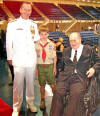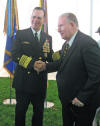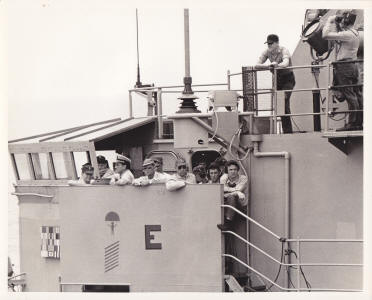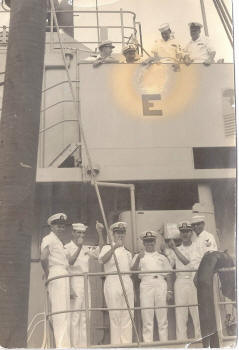Photo of CNO Mike Mullen (Collett 1968)
greeting Capt. John R. Kearney (USN Ret) CO Collett
1966-1968 during the 22 July Change of Command at the
U.S. Naval Academy, when ADM Mullen relieved ADM
Clarke as CNO. Collett was the first duty assignment
of ADM Mullen.
Also in the picture is Nick Fleegal, Capt Kearneys 11
year old grandson.
Change of Command of the Chairman of the Joint Chiefs of Staff.
Admiral Mike Mullen (USS COLLETT 1968) relieved General Peter Pace as Chairman.
Captain John Kearney (Commanding Officer USS COLLETT 1967-1969) is congratulating Mike.
|
(Click to enlarge photo)
|
|
Left to right on the Bridge in 1967: Jerry Dunne, Joe Collins (with hand over his mouth), Andy Bradick (facing forward), Capt Kearney, Robert Perrin (Radioman behind Captain delivering message), Bill Wardell (XO), 3 unknown phone talkers. Also 2 unknown shipmates on the Signal Bridge. Below the Bridge, notice the Operations E and the figure of a man parachuting and the 8 hashmarks.
|
|
(Click to enlarge photo)
I have attached a photo of Collett's OPs Dept leadership after we won
the "E"in 1968
I have identified
some of the crew
Bridge wing Curtis
Cook (CIC) Andy Bradick (OPS), Merle Holloway, Chief Madden
01 level Chief ?,
RM1 Zimmerman, Ens. ?, Ens C. Chadbourne, Ltjg P. Johnson, SM1?
It would be great
if one of our shipmates could ID the rest.
|
|
History of USS COLLETT (DD-730) during 1967 The USS COLLETT
(DD-730), a unit of Destroyer Squadron NINE, was homeported in Yokosuka,
Japan, throughout 1967 under the command of COMMANDER John R. KEARNEY,
473250/1100 USN, of Oakland, California.
As a part of the “fire brigade squadron” of Cruiser-Destroyer
Group, Western Pacific, COLLETT was called upon to perform a wide
variety of missions, many of them in the combat area of the Tonkin Gulf. As the year opened,
COLLETT was enroute from Yokosuka to the Gulf of Tonkin, having stopped
briefly at Buckner Bay, Okinawa, to refuel on 31 December 1966.
The COLLETT anchored in Danang Harbor early on 4 January 1967 and
reported for duty to the Commanding Officer of USS GRIDLEY (DLG-21).
After a busy day of briefings on Tonkin Gulf SAR (Search and
Rescue) operations, the two ships got underway and conducted anti-PT
boat training in the Tonkin Gulf just eastward of Danang late on 4
January. The two ships then
proceeded to Southern SAR station, arriving on 6 January as reliefs for
USS R. K. TURNER (DLG20) and USS HANSON (DD-832).
Ships assigned to SAR have as primary duty the rescue of aviators
downed in combat over North Vietnam. While assigned to SAR, COLLETT
participated in a number of rescue efforts.
The ship’s SAR efforts included in-flight refueling of numerous
helicopters. Even while assigned to
SAR duty, the COLLETT maintained her operational readiness by constantly
engaging in training exercises whenever the opportunity presented
itself. For example, on
January 17, 24, 25, and 26 the ship conducted tactical maneuvering
exercises with the USS GRIDLEY (DLG-21).
On the 25th, an anti-PT boat exercise was held using a UH-2
helicopter from the GRIDLEY to simulate a high-speed surface contact. COLLETT added DASH
(Drone Anti-Submarine Helicopter) to its weapons system on 17 January
1966. It is interesting to
note that on the first anniversary of the ship’s entry into the program,
LTJG Eric C. LEHTO, the DASH officer, accomplished the 200th successful
landing of the bird. The
event was duly celebrated on the ship’s hangar deck, complete with
birthday cake. On February 6 the ship
was detached from SAR station and headed north.
After refueling in Buckner Bay, Okinawa, COLLETT participated in
a large ASW exercise in the Van Diemen Straits of the Philippine Sea.
Appropriately named “Operation Gillnet”, the exercise was held
from February 11 to 14.
Upon completion of the exercise, COLLETT was homeward bound to Yokosuka.
Arriving on February 16, the ship underwent a much needed upkeep
period which lasted into March. On 5 March COLLETT
once more put to sea from Yokosuka and, after a brief fuel stop at
Buckner Bay on 7 March, set course to rendezvous with a carrier task
group of Task Force 77 in the Tonkin Gulf.
On March 10 the ship received unexpected orders for a new
assignment – Operation “SEA DRAGON” – as the flagship of CAPTAIN Ardwin
G. Franch, USN, Commander Destroyer Division NINETY-TWO. “SEA DRAGON” provided
some of the most interesting experiences and severest tests of COLLETT’s
combat effectiveness since the Korean War of the early 1950’s.
The primary object of “SEA DRAGON” operations is the interdiction
of war material flowing from North Vietnam to the Viet Cong by the
bombardment of waterborne logistic craft and other military targets
north of the17th parallel.
This requires the cruisers and destroyers assigned to “SEA DRAGON” to
operate well within the gun arcs of enemy shore batteries on numerous
occasions. The crew of
COLLETT witnessed a grim reminder of the hazards inherent in “SEA
DRAGON” Operations only an hour after arriving on “SEA DRAGON” station.
COLLETT had pulled alongside USS CANBERRA (CAG-2) to highline the
Commanding Officer over to the missile cruiser for briefings and to
transfer Commodore FRANCH and his staff from CANBERRA to COLLETT.
Almost immediately after COLLETT had cleared the side of
CANBERRA, the ship COLLETT was assigned to relieve – USS KEPPLER
(DD-765) – made the side of the cruiser in order to transfer several gun
crew members who had been wounded minutes before by a direct hit between
the gun barrels of KEPPLER’s Mount 51.
That very night COLLETT received her first hostile fire from
North Vietnamese shore batteries, when she was fired upon from Hon Matt
Island while providing suppression fire for CANBERRA during a night “H
and I” (harassing and interdiction) mission.
COLLETT wasted no time in answering the enemy guns.
Opening fire at 15,700 yards, her 5”/38’s expended 103 rounds,
silencing the North Vietnamese guns.
Subsequent aerial gun damage assessment showed the coastal
defense site completely destroyed. Two days later, an
ammunition bunker and gun emplacement were destroyed.
Opening fire at 11,000 yards, two positive secondary explosions
were observed, including one large orange fireball.
COLLETT’s first tour on “SEA DRAGON” was a fairly short one.
On 21 March the ship transferred COMDESDIV 92 and his staff to
the USS CANBERRA and, upon relief by USS A.A. CUNNINGHAM (DD-732) on 122
March, COLLETT departed for Yokosuka.
Arriving on the 27th, the ship remained in home port for upkeep
until the 10th of April.
CAPTAIN FRANCH and his staff rejoined COLLETT on 6 April in Yokosuka. On April 11 COLLETT,
with COMDESDIV 92 embarked, once more steamed down Tokyo Bay enroute to
Operation “SEA DRAGON”. Her
deployment was to be one of the more active of the year.
Enroute to and on station, COLLETT’s schedule provided
considerable opportunity for crew training, including general quarters
drill (practice and actual), shiphandling instruction (particularly in
the area of alongside evolutions), plus three days of DASH operations.
COLLETT arrived on station in the Tonkin Gulf on 17 April,
relieved USS DUNCAN (DDR-874) and commence operations with HMAS HOBART,
the first Australian ship to participate in the Vietnam conflict, as the
Northern SEA DRAGON task unit, under the command of Commodore FRANCH. The next thirty-eight
days were busy and interesting ones for COLLETT and her crew.
Not only was the COLLETT one of the first U.S. Navy ships to
operate with HMAS HOBART in the waters off North Vietnam, but she was
also one of the units selected for the initial on-the-scene coverage of
“SEA DRAGON” by members of the “Fourth Estate.”
On the 24th of April COLLETT anchored in Danang Harbor long
enough to embark eight photographers and reporters for a two-day
observation of “SEA DRAGON” activities.
The newsmen, representing CBS-TV, TIME Magazine, Associated
Press, NEW YORK TIMES, and the LOUISVILLE TIMES, were given a first-hand
view of naval operations off the cost of North Vietnam.
While they were onboard, COLLETT fired several coastal defense
site suppression missions in the vicinity of Dong Hoi, and observed
underway refueling from USS TALUGSA (AO-62) and rearming from USS VIRGO
(AE-30) No matter how modern
its gear, or advanced its tactics, a Navy is no better than the men who
man its ships. To a large
extent it is the professionalism, knowledge, and devotion to conviction
and duty on the part of the American sailor that has made the United
States Navy second to none.
The newsmen embarked in COLLETT must have sensed this fact.
They must have known that the readers at home are interested in
people as well as military statistics.
It is not surprising that one reporter, R.W. Apple, Jr., of the
NEW YORK TIMES, chose to do a feature story on one of COLLETT’s more
interesting characters, Chief Radarman Frank J. MADDEN of the Bronx, New
York City. A veteran of
twenty-four years, Chief Petty Officer MADDEN exhibits well the
professional attitude of a career navy man: “Some people want to be
millionaires or movie stars.
I always wanted to be a sailor – even when I was a little kid
five years old.” On the morning of 26
April the newsmen were highlined to the USS AULT (DD-698) for return to
Danang. The success of this
first eyewitness coverage of “SEA DRAGON” operation by press
representatives was indicated in Commander SEVENTH Fleet’s message
comments a few days later: “ . . . Initial SEA DRAGON media noted with
great pleasure. Reports on
extensive and prominent coverage SEVENTH Fleet operations this period in
all CONUS media are source of satisfaction in which all may share. . . .
My congratulations to all who contributed to this effort to assure
prompt and comprehensive reporting on operations of this significant
period. VADM John J.
HYLAND” COMDESDIV 92 was
relieved as northern “SEA DRAGON” unit commander on April 29th, and was
highlined to the USS SAINT PAUL (CA-73) with his staff the following
afternoon. The COLLETT remained on “SEA DRAGON” under the tactical
command of COMDESDIV 112 embarked in US SAMUEL N. MOORE (DD-747) until
relieved by the USS ALLEN M. SUMNER (DD-692) on 8 May. The periods 11 March
to 22 March 1967 and 17 April to 8 May 1967, during which the ship had
been assigned to “SEA DRAGON“ operations against North Vietnam had
provided a strenuous test of the COLLETT’s combat effectiveness.
The ship’s mission involved continual operations close to the
enemy’s coast, frequently within range of enemy coastal defense sites;
on the two separate occasions (21 and 22 April) COLLETT, together with
other ships in company, was taken under fire by enemy shore batteries.
While on “SEA DRAGON” operations the ship was required to have
the capabilities of accurate navigation fixes, effective gunnery, boiler
power for high speed maneuvers, and rapid and reliable radio
communication immediately available at all times.
Despite two unscheduled extensions on “SEA DRAGON” operations,
the 23 year old destroyer carried out all assigned tasks in
unimpeachable style.
Although the number of observed fire missions during the ship’s first
tour of ”SEA DRAGON” was limited by very poor weather, during the second
tour, from 17 April to 8 May, COLLETT fired more than 2,500 rounds of
five inch ammunition against enemy military targets along the coast of
North Vietnam. In addition
to sinking 30 waterborne logistics craft and damaging 32 others, the
ship was credited with destroying two coastal defense sites, a three-gun
anti-aircraft battery and a mortar position, and with damaging eight
coastal defense sites, two storage areas, a highway bridge and a
causeway. The Commanding
Officer was awarded a bronze Star for the COLLETT’s performance on “SEA
DRAGON”, and eighteen other officers and enlisted men received awards
ranging from Navy Commendation Medals to Commander Cruiser-Destroyer
Group SEVENTH Fleet Commendation in recognition of their leadership,
professional skill, hard work and devotion to duty which contributed in
large measure to their ship’s combat record during this period. COLLETT departed the
“SEA DRAGON” area on 8 May and headed for home port once again.
Pausing only for a brief 11 May fuel stop in Buckner Bay, the
ship arrived in Yokosuka late on the 13th of May.
The rest of the month was spent in upkeep. The first day of June
found COLLETT once more enroute to Southern SAR station in the Tonkin
Gulf, with the usual brief stop for fuel on June 3rd in Buckner Bay.
Arriving in Danang Harbor on 7 June for briefings and SAR
training, COLLETT reported to the USS REEVES (DLG-24) for duty.
The REEVES and COLLETT arrived on South SAR station 9 June.
COLLETT received her SAR turnover folder from USS ARNOLD J.
ISBELL (DD-869) and remained on SAR station “riding shotgun” for the
REEVES through 3 July. The
month of SAR station was relatively quiet.
Although ample opportunity for independent and dual ship training
was taken advantage of, the period was generally tedious, boring and
frustrating, as the tropical sun beat down of the COLLETT and REEVES
patrolling their SAR station in the ripple-less waters of the Tonkin
Gulf. Long hours stretched
into long days, and days to weeks, with occasional underway
replenishments, in-flight helicopter refueling, and Junior Officer
tactical maneuvering drills between REEVES and COLLETT providing the
main breaks in the routine.
However, all the monotonous hours, days and weeks proved worthwhile on
the second of July, when “Clementine 2”, the REEVES’ helicopter,
successfully recovered a downed Air Force pilot from the jungle
southwest of Vinh. On the fourth of July,
the 191st anniversary of the Republic’s birth, COLLETT and REEVES left
SAR station and headed for one of the most popular liberty ports in the
Far East: Hong Kong. Arriving in the British Crown Colony on July 6,
COLLETT’s crew spent an interesting and memorable six day visit that few
would ever forget. Even good things must
end sometime, so on July 12 the COLLETT got underway from Hong Kong and
took departure for Yokosuka.
Arriving in home port on the 16th of July, the ship commenced a
planned availability at Yokosuka Naval Shipyard on the 24th.
Throughout the remainder of July and the first week of August
shipyard workers swarmed about the old veteran at her pierside berth,
and from the 8th to the 30th of August she rested on the keel blocks in
Drydock Number Five.
The six week planned
availability in home port passed all too quickly.
On 1 September the ship underwent sea trials, followed on 11
September by an Operational Readiness Inspection, and on 12 and 13
September by local independent ship exercises in preparation for shoe
bombardment, casualty control, and “Snoopy” operations.
(“Snoopy” is the use of TV cameras on the DASH aircraft for
spotting naval gunfire.)
COLLETT then headed for “SEA DRAGON” on the 15th, continuing her
“Snoopy” trials enroute.
Arriving on the gun line 20 September, COLLETT provided five-inch
gunfire support for USS BOSTON (CAG-1) through the 23rd and for USS
SAINT PAUL (CA-73) for the 24th until the end of the month.
In addition to firing against assigned military targets during
its two weeks on “SEA DRAGON”, COLLETT had the opportunity to use
“Snoopy” to spot both its own fire and that of other gunfire support
ships. Although some
excellent videotape footage was obtained which graphically demonstrated
that ”Snoopy” was a valuable addition to the “SEA DRAGON” operation ,
the month was not without its disappointments.
On 25 September North Vietnamese gunners brought down one of
COLLETT’s “Snoopy” aircraft as it was searching along the coastline
south of Dong Hoi for a coastal defense position which had killed one
crewman of USS MANSFIELD (DD-728) and wounded two others a few hours
earlier. Four days later
COLLETT’s other “Snoopy” helicopter crashed into the water while
hovering off the fantail preparatory to landing on the flight deck. On October 1st COLLETT
joined the USS CONSTELLATION (CVA-64) for screening duty and remained
with the “CONNIE” until the 11th, except for three days of “TAD”
(temporary additional duty) for ASW training with the USS BREAM (SS-243)
from 2 to 4 October.
COLLETT parted company with the CONSTELLATION’s task group on 11 October
and then provided screening services for USS INTREPID (CVS-11) during
her transit to Yokosuka.
Upon arriving in home port on 17 October, COLLETT commenced another
upkeep period. The work of upkeep was
interrupted briefly on Friday, 27 October, by an awards formation at the
Fleet Gym, Yokosuka. At
this formation, appropriately held on Navy Day, the Commanding Officer
formally presented a number of medals and letters of commendation to
various officers and enlisted men of the COLLETT for their performance
in combat operations against North Vietnam.
During this same two week upkeep period the Commanding Officer
and all hands received a letter of commendation from the retiring
Commander-in-Chief of the United States Pacific Fleet, Vice Admiral Roy
L. JOHNSON, for COLLETT’s outstanding achievement in the field of
enlisted retention during the fiscal year 1967.
The citation stated the COLLETT’s combined reenlistment rate of
65 percent was not only the second highest for any ship of
Cruiser-Destroyer Force, U.S. Pacific Fleet, but that it was also three
times the average of all ships within the force.
Furthermore, COLLETT showed the highest relative improvement of
any ship in CRUDESPAC, with an increase of 47 percent over fiscal 1966. November 2nd found
COLLETT underway from Yokosuka again, this time for one of the most
memorable and pleasant assignments of the year: a November 4-6 visit to
the Japanese port of Beppu on Kyushu.
While it would be an understatement to say that the crew enjoyed
thoroughly the numerous tours and sightseeing in the hot spring area
which has long made Beppu a popular resort city, the real tone of the
visit was “People-to-People.”
General visiting was held aboard ship and a special party was
given for thirty children from the “Garden of Light” Orphanage.
Yet the crowning event of the Beppu visit was a sizable blood
donation by eleven crewmen to a seriously hemorrhaging Japanese national
late in the evening of the last day in port.
While the patient later succumbed, the humanitarian spirit of the
America sailor’s effort was not lost on the Japanese populace, as
letters of appreciation from the patient’s widow, the mayor’s office,
the president of Beppu national hospital and articles in the local
Japanese press attested. Departing Beppu early
on the 7th of November, COLLETT once more steamed south for another tour
of “SEA DRAGON” duty.
Arriving off the coast of North Vietnam on 12 November, COLLETT
participated in “SEA DRAGON” Operations for 23 days, operating under the
tactical command of USS CANBERRA (CAG-2), COMDESRON 9 in USS BLUE
(DD-744), USS NEWPORT NEWS (CA-148) and HMAS PERTH.
During this period, on 23 and 24 November COLLETT, together with
USS CANBERRA (CAG-2), USS ROBISON (DDG-12), USS NEWPORT NEWS (CA-148),
and USS NEW (DD-818), participated in Operation “Ballistic Arch”, an
amphibious landing of marines at the DMZ for a search and destroy
mission. COLLETT provided
both area covering fire and “call fire” support for the operation. COLLETT left “SEA
DRAGON” the afternoon of December 3rd, relieving USS CHANTICLEER (ASR-7)
as “shadowing” ship for the Russian intelligence trawler GIDROFON, which
had been maintaining a very close surveillance of American carrier
operations in the Tonkin Gulf.
For three days, until relieved by USS ABNAKI (ATF-96) on the
night of 6 December, COLLETT steamed slowly in the vicinity of the
Russian trawler. At times
the GIDROFON lay dead in the water; at other times she decided to take a
closer look at the American carriers, creating some interesting conning
situations which kept COLLETT’s captain and conning officers on their
toes. Though of short
duration, COLLETT’s three days steaming “in company” with a Soviet
trawler were among her most interesting days of the year 1967. COLLETT left Yankee
Station on 7 December and spent the period 9 through13 December in Subic
Bay for upkeep prior to returning to Yokosuka.
On the 14th the ship left Subic Bay enroute for Japan.
Late that evening, word was received of an international distress
call sent out by a Chinese Nationalist merchant ship, FU-CHIN (UNION
SUCCESS). COLLETT sped at
flank speed to a rendezvous with the FU-CHIN’s last given course.
Finding nothing, the search was continued well into the next
morning until it was learned that FU-CHIN was safely on her way into
Subic Bay. COLLETT arrived
in Yokosuka on the 19th, and the remainder of the year was spent in
upkeep in port. 1967 was a very busy
year for COLLETT. She
actively participated in her third Pacific war, performing every task
currently assigned to destroyers in the Vietnam combat area: “SEA
DRAGON”, Naval Gunfire Support, Carrier escort duty, Search and Rescue,
and even “shadow” ship for a Russian intelligence trawler.
It was a long, yet rewarding year for the ship and her crew.
The ship earned many kudos from tactical commanders for its
performance in action, and many of COLLETT’s officers and men received
individual awards for carrying out their duties in an outstanding
manner. As the year came to
an end, COLLETT and her crew could look back with well deserved pride
and satisfaction on a job well done in 1967. (From Andrew Bradick’s
copy in April 2010; transcribed by Frank Olderr) |



